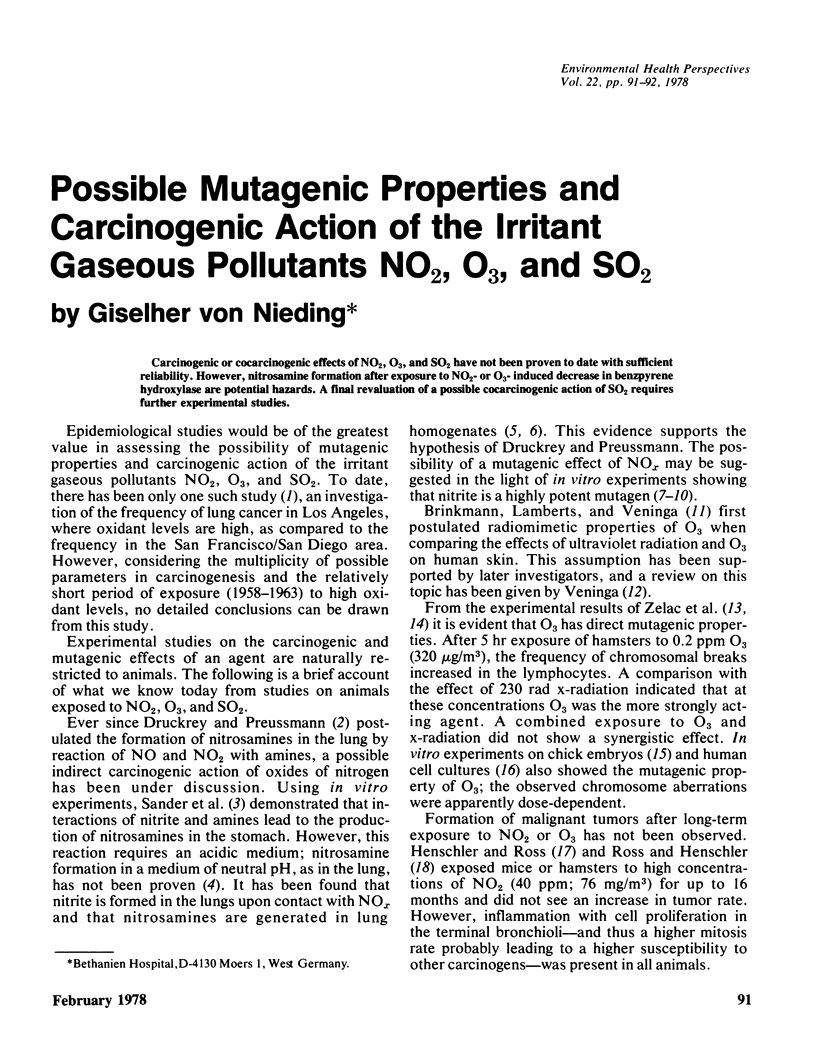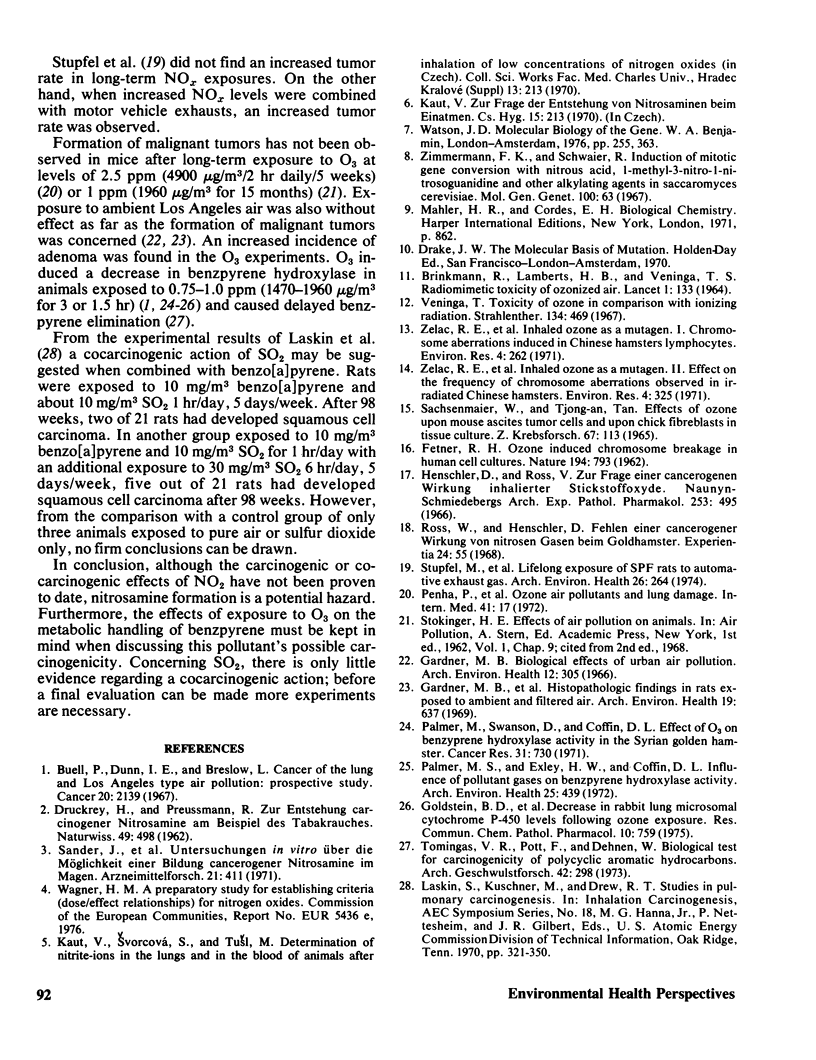Abstract
Carcinogenic or cocarcinogenic effects of NO2, O3, and SO2 have not been proven to date with sufficient reliability. However, nitrosamine formation after exposure to NO2- or O3-induced decrease in benzpyrene hydroxylase are potential hazards. A final revaluation of a possible cocarcinogenic action of SO2 requires further experimental studies.
Full text
PDF

Selected References
These references are in PubMed. This may not be the complete list of references from this article.
- Buell P., Dunn J. E., Jr, Breslow L. Cancer of the lung and Los-Angeles-type air pollution. Prospective study. Cancer. 1967 Dec;20(12):2139–2147. doi: 10.1002/1097-0142(196712)20:12<2139::aid-cncr2820201212>3.0.co;2-8. [DOI] [PubMed] [Google Scholar]
- FETNER R. H. Ozone-induced chromosome breakage in human cell cultures. Nature. 1962 May 26;194:793–794. doi: 10.1038/194793a0. [DOI] [PubMed] [Google Scholar]
- Gardner M. B. Biological effects of urban air pollution. 3. Lung tumors in mice. Arch Environ Health. 1966 Mar;12(3):305–313. doi: 10.1080/00039896.1966.10664377. [DOI] [PubMed] [Google Scholar]
- Gardner M. B., Loosli C. G., Hanes B., Blackmore W., Teebken D. Histopathologic findings in rats exposed to ambient and filtered air. Arch Environ Health. 1969 Nov;19(5):637–647. doi: 10.1080/00039896.1969.10666903. [DOI] [PubMed] [Google Scholar]
- Goldstein B. D., Solomon S., Pasternack B. S., Bickers D. R. Decrease in rabbit lung microsomal cytochrome P-450 levels following ozone exposure. Res Commun Chem Pathol Pharmacol. 1975 Apr;10(4):759–762. [PubMed] [Google Scholar]
- Henschler D., Ross W. Zur Frage einer cancerogenen Wirkung inhalierter Stickstoffoxyde. Naunyn Schmiedebergs Arch Exp Pathol Pharmakol. 1966;253(4):495–507. [PubMed] [Google Scholar]
- Palmer M. S., Exley R. W., Coffin D. L. Influence of pollutant gases on benzpyrene hydroxylase activity. Arch Environ Health. 1972 Dec;25(6):439–442. doi: 10.1080/00039896.1972.10666200. [DOI] [PubMed] [Google Scholar]
- Palmer M. S., Swanson D. H., Coffin D. L. Effect of ozone on benzpyrene hydroxylase activity in the Syrian golden hamster. Cancer Res. 1971 Jun;31(6):730–733. [PubMed] [Google Scholar]
- Sander J., Bürkle G., Flohe L., Aeikens B. Untersuchungen in vitro über die Möglichkeit einer Bildung cancerogener Nitrosamide im Magen. Arzneimittelforschung. 1971 Mar;21(3):411–414. [PubMed] [Google Scholar]
- Stupfel M., Magnier M., Romary F., Tran M. H., Mouted J. P. Lifelong exposure of SPF rats to automotive exhaust gas: dilution containing 20 ppm of nitrogen oxides. Arch Environ Health. 1973 May;26(5):264–269. doi: 10.1080/00039896.1973.10666272. [DOI] [PubMed] [Google Scholar]
- Tomingas R., Pott F., Dehnen W. Biologische Testmodelle für die kanzerogene Wirkung von Polyaromaten. Arch Geschwulstforsch. 1973;42(4):298–306. [PubMed] [Google Scholar]
- Veninga T. S. Toxicity of ozone in comparison with ionizing radiation. Strahlentherapie. 1967 Nov;134(3):469–477. [PubMed] [Google Scholar]
- Zelac R. E., Cromroy H. L., Bolch W. E., Jr, Dunavant B. G., Bevis H. A. Inhaled ozone as a mutagen. I. Chromosome aberrations induced in Chinese hamster lymphocytes. Environ Res. 1971 Aug;4(3):262–282. doi: 10.1016/0013-9351(71)90028-4. [DOI] [PubMed] [Google Scholar]
- Zelac R. E., Cromroy H. L., Bolch W. E., Jr, Dunavant B. G., Bevis H. A. Inhaled ozone as a mutagen. II. Effect on the frequency of chromosome aberrations observed in irradiated Chinese hamsters. Environ Res. 1971 Oct;4(4):325–342. doi: 10.1016/0013-9351(71)90032-6. [DOI] [PubMed] [Google Scholar]
- Zimmermann F. K., Schwaier R. Induction of mitotic gene conversion with nitrous acid, 1-methyl-3-nitro-1-nitrosoguanidine and other alkylating agents in Saccharomyces cerevisiae. Mol Gen Genet. 1967;100(1):63–76. doi: 10.1007/BF00425776. [DOI] [PubMed] [Google Scholar]


